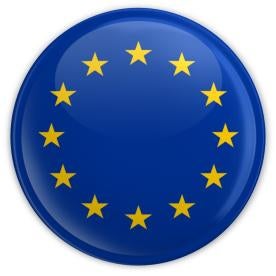Digital Single Market Policy
On April 19, the European Commission launched its “Digitising European Industry” package, a series of industry related initiatives aimed at “updating Europe’s digital infrastructure”. The package includes reports and proposals addressing cloud computing, ICT standardization, eGovernment, Internet of Things (“IoT”), quantum technologies and high performance computing / big data.
As part of the package, the Commission announced the creation of a European Open Science Cloud, which is intended to “offer 1.7 million European researchers and 70 million professionals in science and technology a virtual environment, free at the point of use, open and seamless services for storage, management, analysis and re-use of research data, across borders and scientific disciplines.” In its Communication on ICT standardisation, the Commission has identified five priority areas for standardization: 5G, the Internet of Things, cloud computing, cybersecurity and data technologies.
In April, a draft communication on Online Platforms and the Digital Single Market strategy was leaked from the European Commission, see here. In the draft document, post-dated May 25, the Commission outlines its political approach to supporting the development of online platforms in Europe. The document defines online platforms as “undertakings capable of facilitating direct interactions between users via online systems, and that capitalize on data-driven efficiencies enabled by network effects”.
In the second half of 2016, the Commission is also expected to publish studies on the asymmetry of information between platforms and their users, as well as on intermediary liability and notice-and-action.
On April 11, the Commission launched a public consultation to review and propose changes to the ePrivacy Directive (2002/58/EC). The consultation will run until July 5, 2016. After this period ends, the Commission will review responses and is likely to table a draft legislative proposal by the end of the year. The ePrivacy Directive sets out specific rules concerning the processing of personal data in the electronic communication sector, which supplement the general European data protection framework (the same framework that will be revised by the General Data Protection Regulation). The ePrivacy Directive was last updated in 2009 and is perhaps best known for the so-called “cookie rule” (a law that requires many websites to gather specific consent when using certain cookies and similar technologies) and provisions that address the confidentiality of electronic communications.
On April 13, the Article 29 Data Protection Working Party (“Working Party”), a group consisting of representatives from the European data protection authorities, the European Data Protection Supervisor, and the European Commission, published its opinion on the EU-U.S. Privacy Shield draft adequacy decision. According to the Working Party, the Privacy Shield contains significant improvements compared to the now-defunct EU-U.S. Safe Harbor framework; however, they had certain outstanding concerns and requests for clarification. In particular, the Working Party were concerned that some of the key EU data protection principles are not sufficiently reflected in the Privacy Shield, or have been “inadequately substituted by alternative notions” and that the recourse mechanisms are unclear. The Article 31 Committee (made up of representatives of the Member States) will now meet to analyze the Privacy Shield on April 29 and May 19, when they will vote on the adequacy of the proposed Privacy Shield.
Energy and Climate Change Policy
On April 7, the European Commission published a Roadmap outlining its upcoming Communication on Decarbonizing the Transport Sector. The Communication will address how the EU’s inland transport sector should contribute to the EU’s greenhouse gas emission reduction target of 40% by 2030. According to the Roadmap, transport emissions will reduce with 12% by 2030 compared to 2005 under existing policies and trends, whereas a 17% to 20% reduction is needed to meet the target.
The Communication is expected to be accompanied by legislative and non-legislative initiatives to reduce transport emissions, including the further promotion of carbon-free or less carbon intensive fuels, vehicle efficiency, and managing transport demand. Please find the Roadmap here.
On April 28, the Court of Justice of the European Union declared invalid the maximum annual amount of free allowances for greenhouse gas emissions determined by the Commission for the period 2013-2020. In particular, the Court declared invalid Article 4 and Annex II to Decision 2013/448, which implements a correction factor for the purpose of calculating the maximum amount of free allowances that Member States can distribute. The Court held that the Commission is required to refer only to the emissions of the installations included in the Community system from 2013 onwards, and not to certain other emissions that had been included in the calculation, when establishing the maximum annual amount of allowances. It also held that the Commission is responsible for ensuring that data sent in by Member States is correct.
The consequence of the ruling is that the maximum annual amount of free allowances granted in the EU may rise or drop. The Court’s ruling also impacts the current debate in the European Parliament on the next phase of the ETS, after 2020, as the legislative proposals are based on the same calculation of maximum annual emission allowances.
Internal Market and Financial Services Policies
On April 15, the European Parliament adopted the Trade Secrets Directive, paving the way for its formal adoption by the Council on May 17, 2016. The Directive seeks to harmonize the national trade secrets laws of the Member States, establishing common definitions, procedures and sanctions. It defines “Trade Secrets” as information which: (i) is secret in the sense that it is not generally known or readily accessible to persons within the circles that normally deal with the kind of information in question; (ii) has commercial value because it is secret; and (iii) has been subject to reasonable steps to keep it secret. The Directive should provide companies with a means of redress for theft or misuse of Trade Secrets. The European Parliament inserted provisions regarding freedom of expression and information, seeking to ensure that the rules do not restrict the work of journalists. Following its formal adoption, Member States will have two years to implement the provisions of the Directive in national law.
On April 25, 2016, the European Commission published its first report on the implementation of the Capital Markets Union in Europe. The Capital Markets Union is the Action Plan of the Commission to integrate capital markets and to develop alternative sources of finance, complementary to the traditionally strong bank financing in the EU. Since its announcement in September 2015, the Commission presented legislative proposals on the calibration of capital requirements for banks (see here), common EU rules on securitization; a simplification of the Prospectus Directive (see here), and a revision of the delegated act on regulatory capital requirements held by insurance and reinsurance undertakings.
Meanwhile, the Commission has started a public consultation on business restructuring and insolvency rules in Europe. Stakeholders have until June 14, 2016 to provide input to the Commission. The public consultation will contribute to a legislative proposal announced for the end of this year.
In 2016, the Commission intends to present legislative proposals to upgrade rules on European Venture Capital Funds (EuVECA) and European Social Entrepreneurship Funds (EuSEF), as well as a review of the Capital Requirements Regulation (CRR) for banks as regards infrastructure calibration. Please find the full report here, and the press release here.
At the end of March, Cyprus exited its 2013 Eurozone bailout program, turning down the last € 2.7 billion of the € 10 billion package. The news was hailed as a success by the Commission. The bailout was made up of loans of € 6.3 billion from the European Stability Mechanism (ESM) and € 1 billion from the International Monetary Fund (IMF) under its Extended Fund Facility. The fourth country to exit the Eurozone bailout program, after Ireland (in 2013), Spain and Portugal (both in 2014), Cyprus is due to finish repaying the loans granted by the ESM by 2031. On April 6, meanwhile, Hungary made a € 1.5 billion payment to the EU, the final repayment for loans of € 15.6 billion granted in its 2008 bailout programme from the IMF, the EU and the World Bank.
Meanwhile, the outlook for Greece remains difficult. The latest round of negotiations with its creditors – EU, IMF, European Central Bank and the ESM – on a third bailout package have been clouded by a damaging leak of a discussion within the IMF, published April 2, in which its officials speculated that Greece would need a new “crisis event” to spur it to action. The two real sticking points in the negotiation appear to be more substantive: apparent disagreements between the creditors on the economic outlook for Greece – where the IMF sees the EU as overly optimistic – and on the IMF’s recommendation that the EU grant Greece a measure of debt relief – which certain Member States, including Germany, are said to have resisted. The remarks of Jeroen Dijsselbloem, the Dutch Finance Minister and president of the Eurogroup of Eurozone finance ministers, following their April 22 meeting, suggested however that there may be some movement on reprofiling Greece’s debts, which could help ease repayments.
On April 7, 2016, the European Commission presented its Action Plan on Value Added Tax (VAT), outlining a set of measures intended to modernise VAT in the EU. The Plan outlines four areas on which the Commission plans to act, to resolve the difficulties it sees for businesses and consumers operating cross-border. The first encompasses a proposal to modernise and simplify VAT for cross-border e-commerce and measures to simplify VAT compliance for small and medium enterprises. The second contains various proposals to tackle the estimated € 170 billion in VAT revenue that the Commission judges is lost every year (see the Commission’s 2013 Report, here). The third would establish a definitive VAT system for cross-border trade. The fourth would grant Member States more freedom in setting VAT rates – including a zero rate of tax on sanitary products, as noted in the Council conclusions of March 17 (see here). This had been a political priority for the UK, and a sticking point in the Brexit debate. The Commission will present its detailed proposals in 2016 and 2017.
On April 12, the European Commission proposed a Directive that would boost corporate tax transparency by introducing public reporting requirements for multinationals operating in the EU. In line with global OECD initiatives on tax transparency, it would require all corporate groups with global revenues exceeding € 750 million a year to publish key information on where they make their profits and where they pay their tax in the EU. For every country in which they operate, such groups would have to publish the nature of their activities; staff numbers; net turnover; profit before tax; all tax due based on yearly profits; all tax actually paid in that same year; and their accumulated earnings. They would also have to disclose the total tax they pay outside the EU. The proposed Directive will now be considered by the European Parliament and the Council. Please find the proposed Directive here.
Trade Policy and Sanctions
On April 15, 2016, the European Medicines Agency’s Pharmacovigilance Risk Assessment Committee (“PRAC”) adopted rules of procedure on the organization and conduct of public hearings in the context of safety referral procedures. The hearings mainly aim to assess “the acceptability of the risks associated with the medicinal product/medicinal substance/class of medicinal products concerned, particularly in relation to its therapeutic effects and therapeutic alternatives available, as well as to seek suggestions and recommendations on the feasibility and acceptability of risk management and minimisation activities.” Public hearings will be held on a case-by-case basis depending on the seriousness of the safety concern, among other criteria. A dry run of the process for such hearings will take place on July 4 to 7, 2016.
These public hearings represent a new means of involving all members of the public, including EU citizens, patients and healthcare practitioners, in the assessment and supervision of medicines. This system has been made possible by the Pharmacovigilance legislation. The EMA’s Management Board had already endorsed the rules of procedure in March 2016.
Trade Policy and Sanctions
In April, the European Commission and China reached an agreement for China to Participate in Juncker’s investment fund. Through its “Silk Road Fund,” China will contribute to the so called European Fund for Strategic Investments (EFSI), the fund set up to implement the investment plan for Europe launched last year by EU Commission president Jean Claude Juncker. A working group had been set up in September 2015 to find the best solution to channel the impressive contribution – between 5 and 10 Billion Euros – that China was prepared to offer. The agreement provides that China will have to fulfil the same rules applicable to private investors, a Commission official explained. In addition, China will have to meet all EU rules on public procurement, labour law or environmental regulations, when investing under the scheme.
On April 16, High representative for EU Foreign Policy Federica Mogherini led an important delegation of European Commissioners to Tehran. It included Elzbieta Bieńkowska (Internal Market), Miguel Arias Cañete (Climate Action and Energy), Christos Stylianides (Humanitarian Aid), Violeta Bulc (Transport), Carlos Moedas (Research), Karmenu Vella (Environment, Maritime Affairs and Fisheries) and Tibor Navracsics (Education and Culture). Their visit took place in the framework of the Joint Comprehensive Plan of Action implemented in January 2016, after the successful conclusion of the negotiations on Iran’s nuclear program. The Commissioners all met with their Iranian counterparts.
Mere days earlier, on April 11, Member States extended targeted sanctions on Tehran in response to serious human rights violations. The sanctions include an asset freeze and visa ban on 82 persons and one entity responsible for “grave human rights violations,” as well as a ban on exports to Iran of equipment which might be used for internal repression and monitoring telecommunications.
On April 24, in Hanover, President Barack Obama and Chancellor Angela Merkel made a joint pitch for more transatlantic trade, a day after a huge demonstration in the same city echoed the mounting opposition to the Transatlantic Trade and Investment Partnership (TTIP) deal on both sides of the Atlantic. Obama said he anticipated the agreement could be concluded by the end of this year, noting that “time is not on our side […] if we don’t complete negotiations this year, then upcoming political transitions in the United States and Europe would mean this agreement won’t be finished for quite some time”. Merkel declared that the deal would be “extremely helpful for growth in Europe”. But the 13th round of talks, which took place in New York the following week, did not mark any clear breakthrough. It rather confirmed substantive divergences on key issues like agriculture, geographical indications, public procurement and even tariffs.







 i
i


